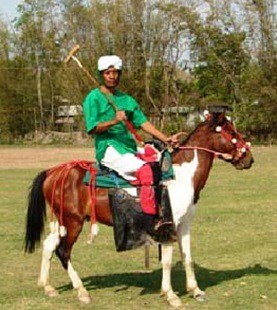Type the name of the breed you're looking for below
[wpdreams_ajaxsearchlite] Don't see the breed your're looking for? Click here and let us know!
Manipuri pony
| Country Of Origin | India |
| History and Background | Sources disagree as to the exact origins of the Manipuri pony, although all agree that it was derived from ancient stock. One source gives the ancestors of the pony as Tibetan ponies brought into India over a thousand years ago, while another states their origins to be a cross between the Mongolian Wild Horse and the Arabian, brought to India by invading Tartar tribes, who also brought the equestrian game of polo. Manipuri ponies have been bred for centuries in the Manipur area of northeast India. The first written mention of the breed dates to a brief statement in the 1584 Manipur Royal Chronicle. By the early 1600s, the breed was mentioned frequently in Manipur literature. They were often used as cavalry horses, and were ridden by Meitei warriors. Manipuri ponies played a major part in the cavalry commanded by Garib Newaz, whose horsemen terrorized upper Burma throughout the early 1700s and in 1738 were used during his Sack of Sagaing. Between 1859 and 1916, Manipuri ponies were extremely desired by the British for playing polo, and there were further infusions of Arabian blood in the 19th century, as British administrators and military officers sought to upgrade their polo ponies. The height of polo horses was initially restricted to 13 hands (52 inches, 132 cm), based on the average height of the Manipuri, and although this restriction was later relaxed to 14 hands (56 inches, 142 cm) and then removed altogether, demand for Manipuris was so high that the area was drained of them. At one point during this period, the export of ponies from Manipur was banned to allow the breed time to increase in number to a viable level. Manipuris were also used to transport British troops into Burma throughout World War II. In 1977, the Manipur Horse Riding and Polo Association was established to promote the Manipuri pony breed and the game of polo. In recent years, breed numbers have decreased, and estimates place the breed at somewhere between 2,300 and 1,000 in population in the 21st century. Population numbers continue to dwindle in part due to high numbers of ponies being smuggled into Myanmar (Burma), where the breed is in demand, after either having been purchased or stolen from their Indian owners. In 2005, a heritage park was begun by the Manipur Horse Riding and Polo Association with the goal of preventing the extinction of the breed and promoting them to tourists. |
| Use Today | Game pony, Riding pony |
| Height | 11 to 13 hands (44 to 52 inches, 112 to 132 cm) |
| Colour | Bay, Chestnut, Gray, Pinto |
| Characteristics | The Manipuri breed has a light head with a straight profile, set on a well-formed neck, somewhat pronounced withers, a deep chest and sloping shoulders. The croup is sloping, the legs sturdy and the hooves well-proportioned. The breed's overall appearance is elegant, an inheritance from their Arabian ancestors. They are often bay in colour, but can also be pinto, gray and chestnut. Because of the short height of the ponies, riders use shortened mallets while playing polo. The Manipuri pony resembles, and is distantly related to, the Burmese Pony and the Indonesian Batak and Sumba ponies. In 2007, a study was published that examined genetic variation among five Indian equine breeds—the Manipuri, Marwari, Spiti, Bhutia, and Zanskari. Based on analysis of microsatellite DNA, the Manipuri was found to have the greatest genetic distance from the Marwari, and a much closer genetic distance to the other three breeds. The distance from the Marwari was not only genetic, but seen in physical characteristics, particularly height and environmental adaptability. The physical differences were attributed to differing ancestries: the Marwari horse is closely associated with the Arabian, while the four other breeds are thought to have descended at least in part from the Tibetan pony. None of the breeds in the study were found to be closely genetically associated with the Thoroughbred. |
| Other Considerations | Polo was introduced into the area of Manipur state as early as the seventh century, and Manipuri ponies were one of the first breeds used in the game. The British learned of polo during the 19th century while watching it played on Manipuri ponies in India. The breed is still used for polo today in India, but other breeds are more popular in Europe and America. Manipuri ponies are often also used to play sagol kangjei, a version of polo believed to be close to what was originally played when the sport was invented. Sagol kangjei is more demanding than modern polo, as ponies are used for the entire match instead of being changed between periods. Manipuri ponies are also used for racing. During their early history, they were in demand as cavalry horses, and men that rode these ponies were thought well-mounted. They continue to be in demand for military uses. |



